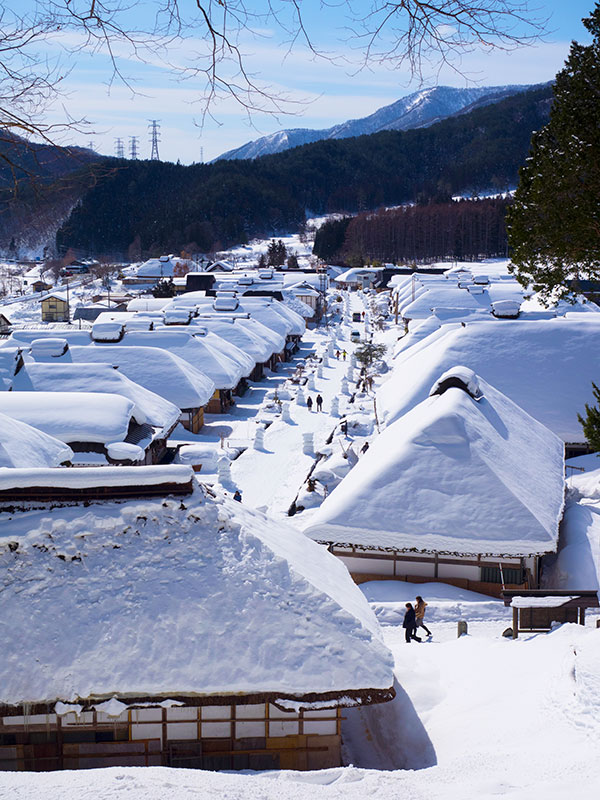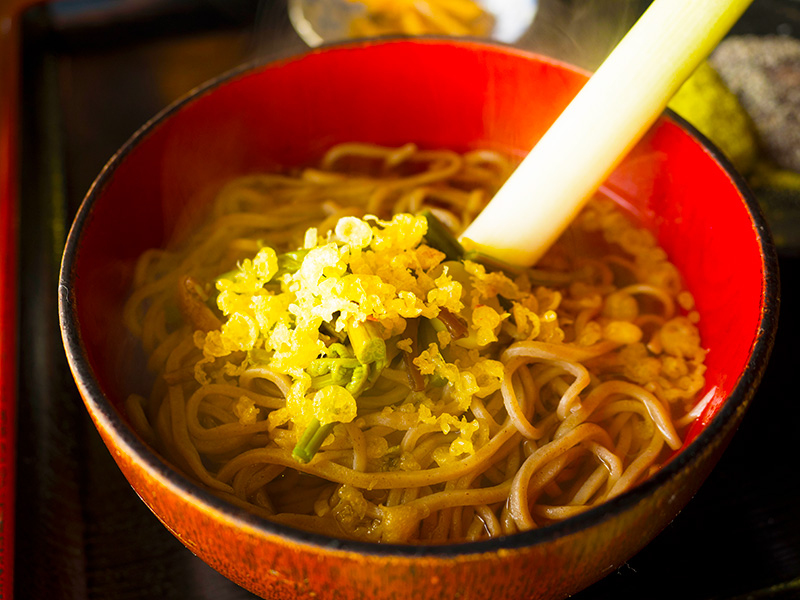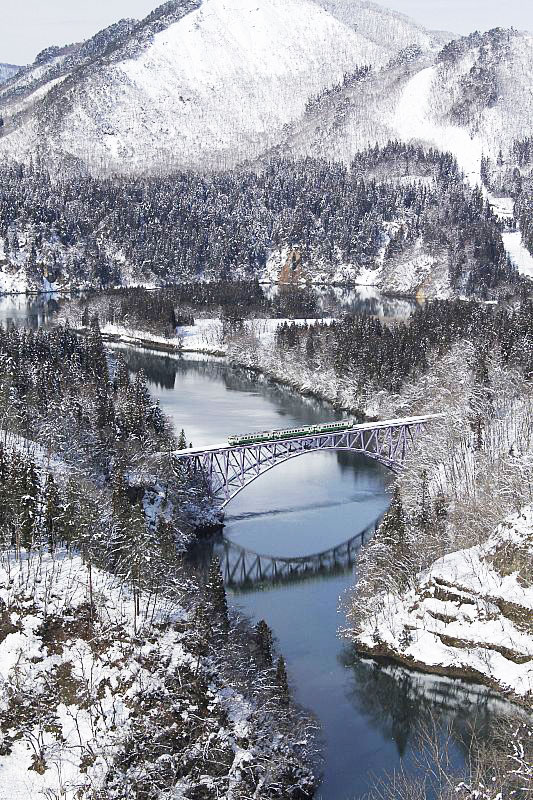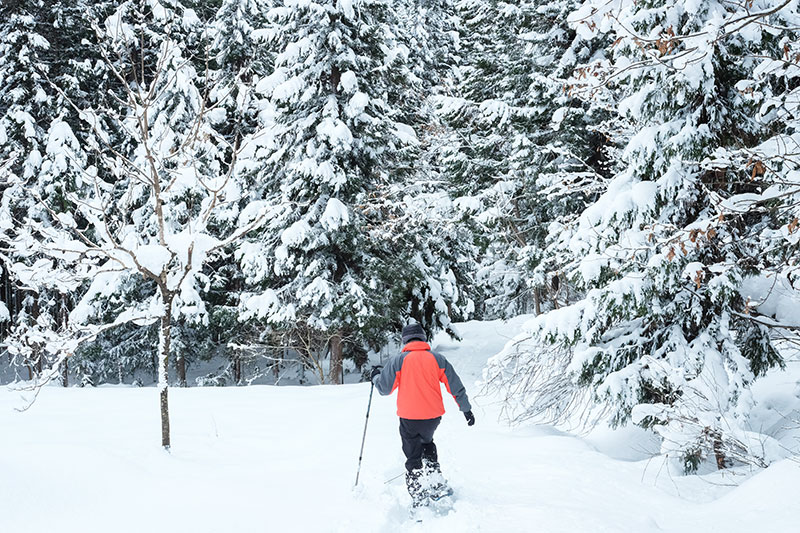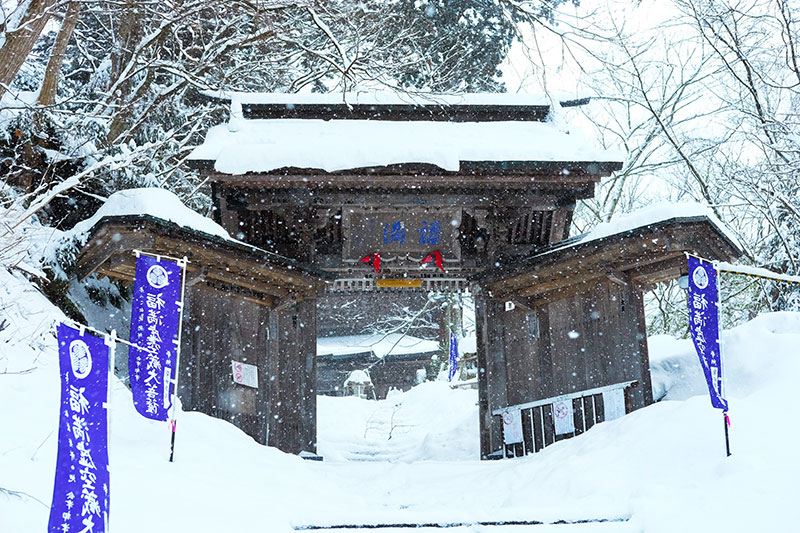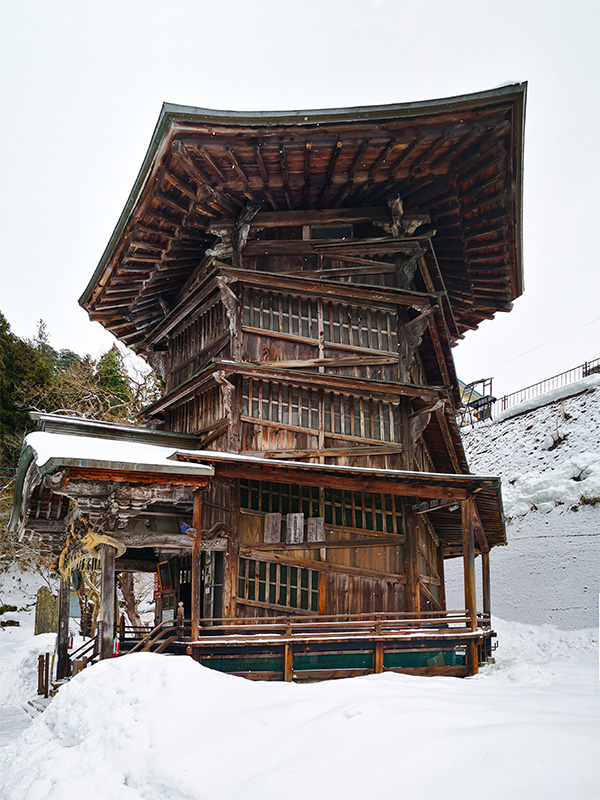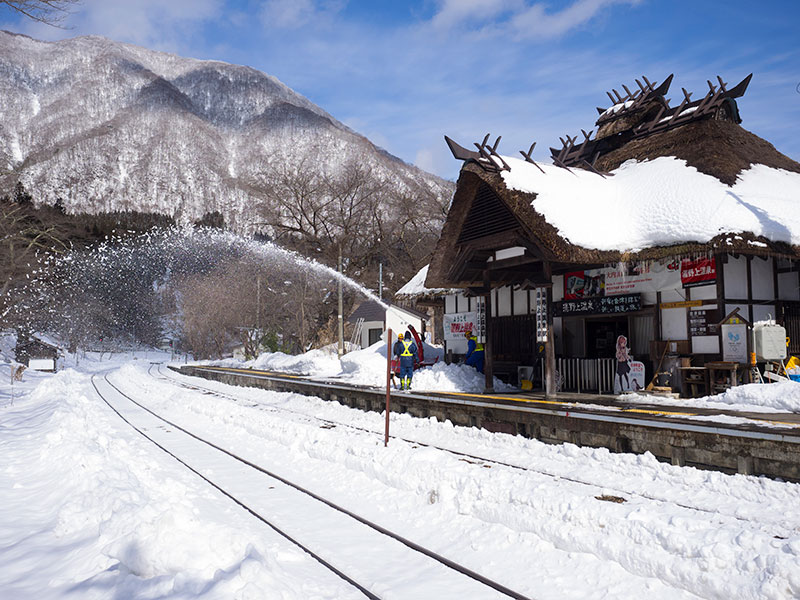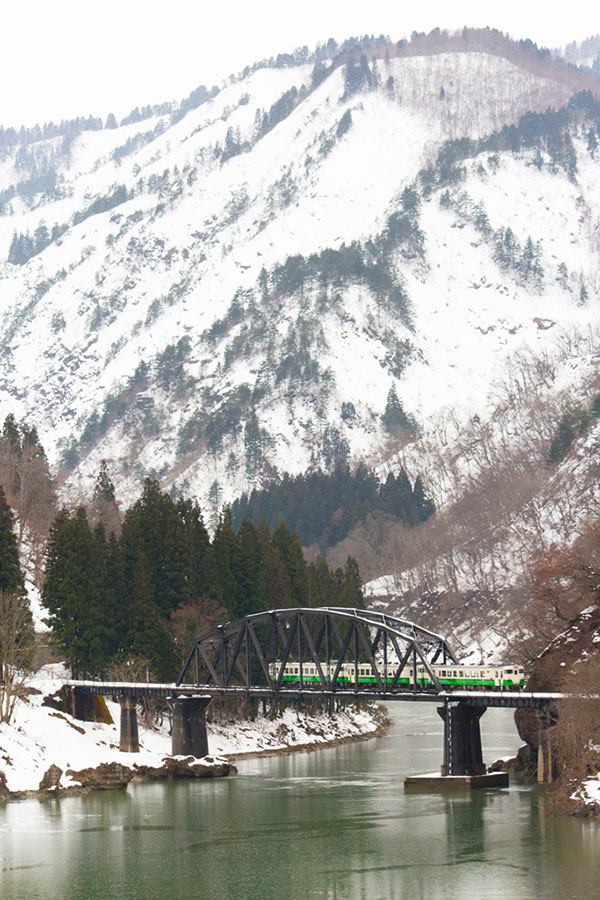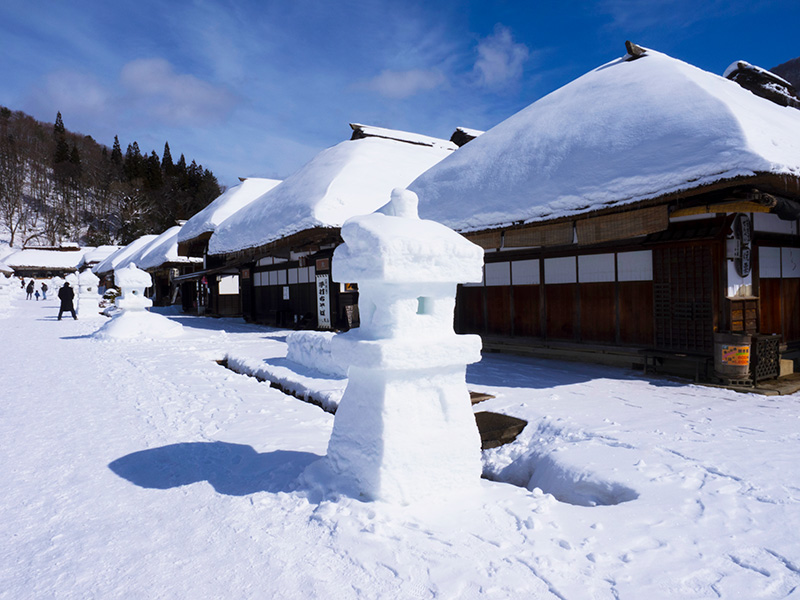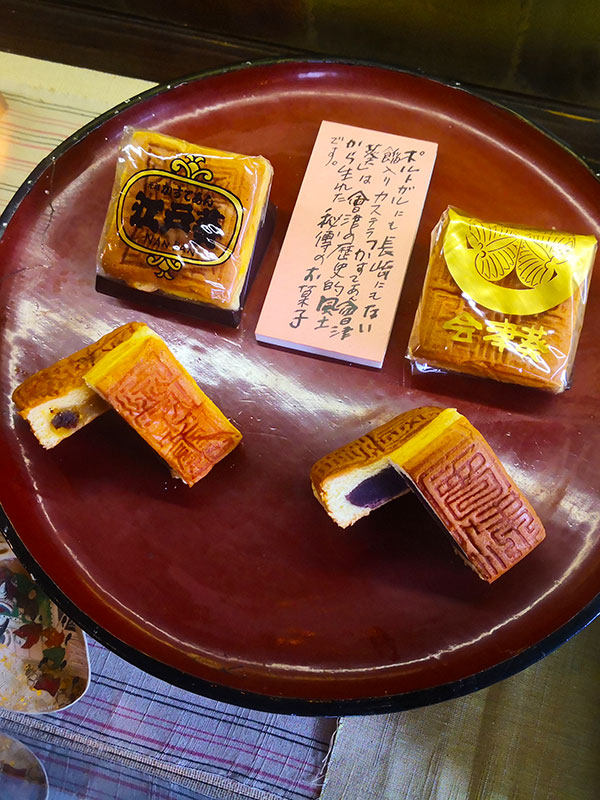An easy snowshoeing tour in rural Aizu in Japan’s Tohoku region with strong emphases on onsen hot springs and Japanese gastronomy.
Gentle guided snowshoeing along trails through snowy rural landscapes. Mountain and valley scenery, pretty villages, and limpid rivers enveloped deep in snow. Light and enjoyable exercise combined with plentiful onsen hot spring baths and opulent cuisine. Accommodation in Japanese inns.
Late December - early March.
A five-day, four-night tour starting in Aizu-Wakamatsu and finishing at Inawashiro Station near Urabandai. Accommodation is in modern Japanese inns with onsen thermal hot spring baths. Please read more on accommodation here. The small intimate nature of the tour makes the maximum group size 12 people. We have no minimum size. If we accept a booking we guarantee to run the tour.
On an Onsen Gastronomy tour, in the company of an expert Walk Japan tour leader, we are immersed in the Japanese way of bathing; stay each evening in pleasant accommodations including some top hotels in the area, almost always with their own onsen; and enjoy sumptuous meals that satisfy both the eye and the stomach. Our light guided strolling allows us to thoroughly enjoy the beautiful countryside we visit and also aids digestion of the gourmet meals, delicious titbits, sakes and other drinks included in the tour.
In flavour, quality of ingredients, range of dishes, health benefits, and sheer artistry of presentation, Japanese cuisine counts amongst the world’s best. Japan’s gastronomic offerings are an appetising and convivial element of all our tours, but in the Onsen Gastronomy series of tours we take this feature to a higher level for a celebration of the quintessential Japanese art of dining.
Onsen hot springs, enjoyed on many of our tours, are found throughout the length and breadth of Japan and are one of Japan’s great attractions; a perennial favourite amongst Japanese and overseas visitors alike. Enjoyed over the millennia for their relaxing, curative and restorative powers, onsen were used in Buddhism, which first arrived in Japan in 552, for purification rites. To this day, bathing in Japan remains a ritual, an art distinctly Japanese.
This fully-guided tour visits Aizu-Wakamatsu and the surrounding Aizu region in Japan’s northerly Tohoku region where snow falls deeply each winter season. Besides creating beautiful winter landscapes, the snow is a delightful companion to the onsen hot springs we enjoy throughout this tour. The locals also believe that the long winters experienced in Aizu are vital to the high quality of the food sourced from the surrounding fields, rivers and mountains. Certainly, the rice grown here is highly regarded for its quality throughout Japan not just for the table but also in the making of sake, Japan’s iconic drink. Aizu produces some of Japan’s finest sake, a delicious attraction that we fully enjoy on our travels here.
Perhaps because of the rugged terrain found here and the long winters, the locals are a tough people and, over the ages, they have been in the vanguard of the samurai tradition. Fiercely loyal to the Tokugawa shoguns during the Edo Period (1603-1868), Aizu warriors were often relied on to defend the shoguns’ interests throughout northern Japan. Samurai feats of derring-do and sacrifice, which the locals are proud of to this day, are woven into our tour and illustrated by the wonderful Tsuruga-jo castle and Oyakuen Japanese garden, where the sharp-eyed will spot gashes wrought in battle by a katana sword blade on an otherwise tranquil tea house.
The tour begins at Aizu-Wakamatsu Station on Day 1, where your Walk Japan Tour Leader awaits. Appropriately, we begin with lunch at a delightful family-run restaurant specialising in local dishes, before exploring Aizu-Wakamatsu’s samurai heritage. From Day 2, however, we largely leave the urban environment behind and delve into the beautiful scenic, snowy countryside. We follow in the footsteps of samurai to visit one of Japan’s most picturesque villages, Ouchi-juku; our short walks are often on snowshoes, which allow us to make our way, often amusingly, over deep snow; and we supplement our travels with a ride on one of the most delightful local railways found in Japan. En route, we savour local food delicacies during the day and every night stay in Japanese inns, where we luxuriate in onsen baths before our evening meals, which are always a lovingly prepared feast. We complete our tour in Urabandai, a region of lakes with waters vibrantly tinted by minerals set against the backdrop of a towering volcano.
Please note that Aizu is in the western interior of Fukushima Prefecture, which experienced the earthquakes and tsunami that hit the eastern seaboard of Japan in March 2011. Fortunately for the Aizu region, it escaped significant contamination from the subsequent nuclear accident in 2011, and current background radiation levels are lower than many major cities around the world. It is approximately 170km (105 miles) at its nearest point from the restricted area around the power plant.
We are confident that travel to Aizu entails no more risk than visiting any other destinations in Japan. However, if you would like to know more about the situation please refer to your government’s travel advice. Additionally, Fukushima Prefecture provides comprehensive details on every aspect of the situation, and WorldNomad and Safecast websites respectively provide independent analysis and data.
Important: Please note that in Japan it has traditionally been the custom not to allow anyone with tattoos to use public baths, including onsen. Although this custom is currently being relaxed, entrance is at the discretion of each establishment. Access at additional cost is usually allowed, however, to kazoku-buro private bathing facilities, which are found at many onsen, for anyone – including those with tattoos.

Day 1 Aizu-Wakamatsu - Yunokami Onsen
The tour begins late morning at Aizu-Wakamatsu Station, where your Walk Japan Tour Leader awaits your arrival. We board a private-hire vehicle with our luggage and immediately head out to lunch at a charming, family-run local soba buckwheat noodle restaurant. Following which we continue with our exploration of Aizu-Wakamatsu, a genteel city with a fascinating, if sometimes bloody, samurai warrior history.
In the warm comfort of a private-hire vehicle, we visit some of the city’s snow-enveloped highlights including the intriguingly built Sazaedo pagoda, Oyakuen Edo-Period herbal and pleasure gardens, and Tsuruga-jo, the historic castle around which Aizu-Wakamatsu developed. En route we learn of the historical figures associated with the area including the legendary one-eyed warrior chief Date Masamune, the Tokugawa family who ruled all Japan in the Edo Period (1603-1868), and the Byakkotai, a group of warrior youngsters who met a tragic end in defending their domain from government forces in 1868.
A short drive from the castle brings us to Yunokami Onsen and our delightful Japanese-style accommodation for the next two nights. Here we luxuriate in the soothing hot spring baths before enjoying a traditional Japanese banquet dinner.
Accommodation: Traditional Japanese inn with onsen hot spring baths.
Meals: Lunch & dinner provided.
Total walking: 2km (1.3 miles).
Total elevation gain: 32m (105ft).
Day 2 Yunokami Onsen - Ouchi-juku - Yunokami Onsen
After breakfast we set out for today’s foray by private-hire vehicle. Our first visit is to one of Japan’s most unusual and picturesque train stations, which sports a thatched roof and onsen foot bath.
A further short journey brings us to Ouchi-juku, a secluded post-town on the ancient Shimotsuke Way. With deep snow all around us we use snowshoes for a wonderfully entertaining and sometimes amusing exploration around this beautiful post-town, which still looks much as it did in its heyday during the Edo Period (1603-1868). Once a thriving place of nourishment and rest for travellers on foot, today Ouchi-juku is lovingly maintained in its original style of traditional thatched buildings that are clustered in two lines either side of the old road. Here we enjoy the local signature dish of negi-soba onion buckwheat noodles, served in one of its atmospheric buildings, for lunch.
We re-board our vehicle to visit Hongo, which is famed locally for its four hundred year-old pottery tradition. Initially established to create the tiles used in the construction of Aizu-Wakamatsu’s Tsuruga-jo castle and subsequently Hongo’s potters each developed their own colourful unique work in porcelain or ceramics for everyday tableware use.
We return to our delightful hot spring accommodation for another soothing, relaxing time in the baths. Another mouthwatering evening meal together follows.
Accommodation: Traditional Japanese inn with onsen hot spring baths.
Meals: Breakfast, lunch & dinner provided.
Total walking: 3km (1.9 miles).
Total elevation gain: 20m (66ft).
Day 3 Yunokami Onsen - Oku-Aizu - Yanaizu
Today, we head to Oku-Aizu, the deep interior of the Aizu region, to the picturesque Mugenkyo, a gorge through which runs the Tadami River.
A local joins us to guide us through the countryside here, its history and society. Born into a family of boat builders and boatmen, who for generations were vital to the local community that relied on the river for its livelihood, our guide describes life over the ages in this gorgeous but demanding and remote environment.
After lunch we transfer by vehicle to nearby Numazawa-ko, a caldera lake formed millennia ago by a volcanic explosion, for an afternoon stroll. The snowfall here is some of the heaviest in the region and, in order to easily make our way, we are once again aided by snowshoes for an enjoyable walk aside the lake. We board a train on the charming Tadami Line bound for Yanaizu. The scenery from the carriage windows is some of the most spectacular in Japan.
Our accommodation tonight is a family-run inn beside the Tadami River. We refresh ourselves in our accommodation’s onsen before a mouth-watering multi-course evening meal composed of local dishes.
Accommodation: Modern Japanese inn with onsen hot spring baths.
Meals: Breakfast, lunch & dinner provided.
Total walking: 3.5km (2 miles).
Total elevation gain: 164m (538ft).
Day 4 Yanaizu – Urabandai
After breakfast, a private-hire vehicle picks us up to visit a venerable and ornately impressive Buddhist temple, which was established over 1,200 years ago, before we journey on to Urabandai.
En route, we pass through a small town where salt has been produced from onsen waters for hundreds of years. The salt derived here has a subtly different flavour and is a popular cooking ingredient throughout the Aizu region. It is also used in sweets, traditional youkan soft bean cake and even soap.
Nearby is one of the region’s many sake breweries. Here we learn why the region produces some of Japan’s finest sake and enjoy a sample or two, before journeying on to Urabandai, a distinctly different, rugged rural region, in time for lunch.
Bandai-san, an active volcano, towers over a scenery of myriad lakes, both large and small. Bandai-san exploded in the late 19th Century with the emitted debris damming rivers and creating this district of lakes. Due to the variety of minerals emitted in the eruption, the waters here shimmer in different colours from cobalt blue to sepia red. We explore a snow-covered trail around the lakes, once again using our snowshoes.
Our accommodation tonight is in the mountains here and, after soaking in the soothing onsen baths once more, we revel in another evening banquet.
Accommodation: Lodge with onsen hot spring baths.
Meals: Breakfast, lunch & dinner provided.
Total walking: 2km (1.3 miles).
Total elevation gain: 55m (180ft).
Day 5 Urabandai - Inawashiro Station
The tour ends at Inawashiro Station, which is a short journey by bus from our tour accommodation. The Walk Japan Tour Leader will be on hand to help you purchase tickets for onward journeys to Tokyo and beyond as necessary.
Accommodation: N/A.
Meals: Breakfast provided.
Total walking: N/A.
Total elevation gain: N/A.
This itinerary is subject to change.
-----
FROM TOKYO’S HANEDA AIRPORT (HND)
Tokyo Monorail trains depart for and terminate at Hamamatsucho Station. Transfer here to the trains on either the JR Yamanote or JR Keihin-Tohoku Lines for Tokyo Station. To Aizu-Wakamatsu from Tokyo Station please see the section below
-----
FROM TOKYO’S NARITA AIRPORT (NRT)
JR Narita Express (NEX) trains depart every 30 minutes for Tokyo Station. To Aizu-Wakamatsu from Tokyo Station please see the section below.
-----
FROM TOKYO STATION
The journey to Aizu-Wakamatsu is made on the JR Tohoku-Yamagata Shinkansen, one of the super-fast bullet train lines, to Koriyama for transfer to the Banetsu Line for Aizu-Wakamatsu. Departures to Koriyama are 4 times every hour and the total journey to Aizu-Wakamatsu is between 3 to 4 hours.
The pre-tour pack includes detailed instructions, including a map, for travel to the accommodation at the start of the tour.
Please note that travel by train from Inawashiro Station to Narita Airport via Tokyo Station takes approximately 5 hours and to Haneda Airport approximately 4.5 hours.






